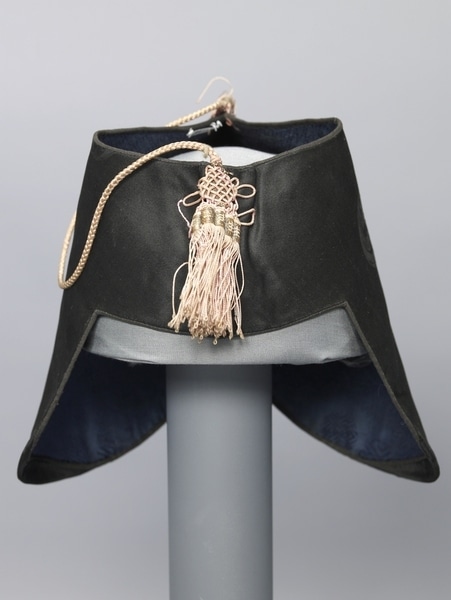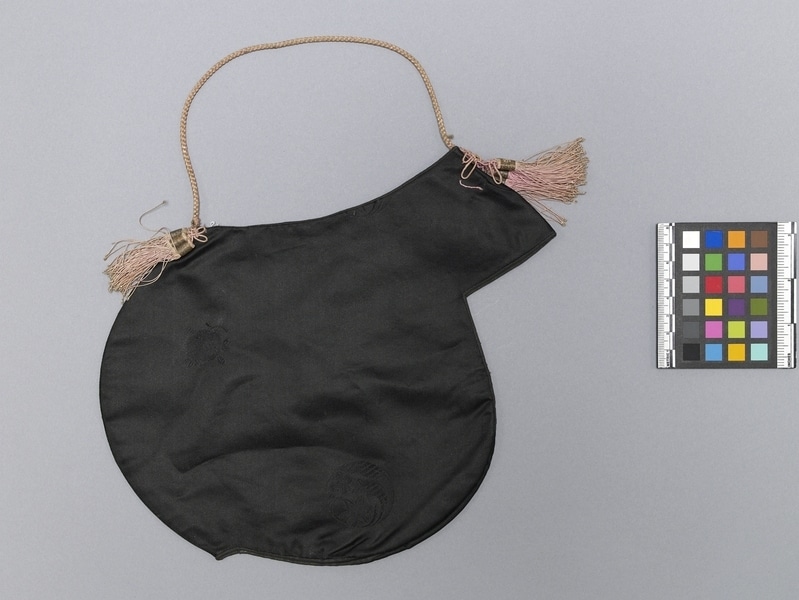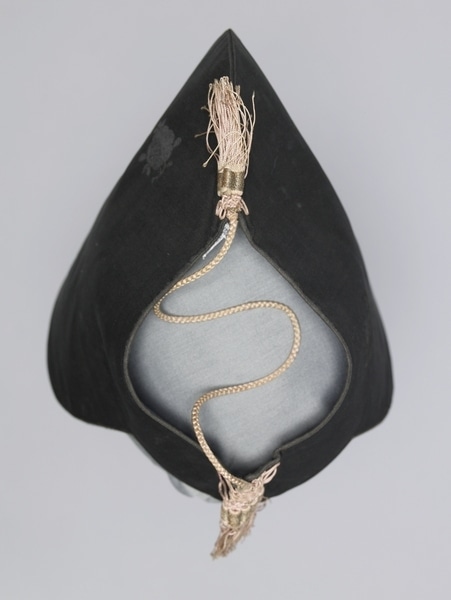Open-top Hat Item Number: Ed1.288 from the MOA: University of British Columbia



Description
Cap of black silk damask with widely spaced roundels and floral motifs. The cap is made of two halves joined at a centre seam from front to back, except for the opening at the top, round when worn. This opening and the forehead area are edged with narrow piping. The edge of the cap is straight across the forehead, but then is cut at a right angle so that it covers the ears. The lower edge forms a circle from the right angle to the top opening. The outer fabric is folded under at the ears and threaded on a cord. The cap is lined with blue-green rayon damask with geometric stepped designs and roundels. A pink silk cord extends loosely across the top opening, attached at the centre front and back. At the back are suspended three pink tassels wrapped in silver thread. At the centre front is a complex knot design in pink cord, and five pink tassels.
History Of Use
Such caps were worn by older women of the official “Yangban” class before 1930. They are now being used again by women for decorative purposes on special holidays. They were worn for warmth in the winter, but the top opening prevented the wearer from getting too warm. Some had a cord in the lower edge which allowed the wearer to pull the cap tightly against her face to keep warm. Such caps normally were made of black satin on the outside, but lined with cotton to absorb perspiration. Those made for young girls were more highly decorated with tassels and gold stamps. They had ornaments sewn on the front and back that could be of gold, silver, jade, or red jade, and they usually had Chinese characters on them expressing wishes for happiness, long life, fortune, and many sons. Such finely-sewn caps were likely to have been made in workshops, although they could be made at home. The gold stamp work was done by masters in workshops.
Item History
- Made in Korea during 1930
- Owned by Hi Soon Kim before June 21, 1983
- Received from Hi Soon Kim (Seller) and Museum of Anthropology Shop Volunteers (Funding source) on June 21, 1983
What
- Name
- Open-top Hat
- Identification Number
- Ed1.288
- Type of Item
- hat
- Material
- silk fibre, rayon fibre, dye and silver metal
- Manufacturing Technique
- spun, woven, dyed, cut, sewn, braided and wrapped
- Overall
- height 27.0 cm, width 23.0 cm
Who
- Culture
- Korean
- Previous Owner
- Hi Soon Kim
- Received from
- Hi Soon Kim (Seller) and Museum of Anthropology Shop Volunteers (Funding source)
Where
- Holding Institution
- MOA: University of British Columbia
- Made in
- Korea
When
- Creation Date
- during 1930
- Ownership Date
- before June 21, 1983
- Acquisition Date
- on June 21, 1983
Other
- Item Classes
- textiles
- Condition
- good
- Accession Number
- 0894/0005